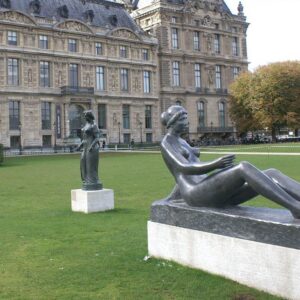When you walk through a park or museum, you might see majestic statues of people, or you might be drawn to more abstract sculptures. Many people wonder: What’s the difference? Why do some call them “statues” and others “sculptures”?
Simply put, all statues are sculptures, but not all sculptures are statues. Statues are typically figurative representations of people or animals, carrying commemorative or symbolic meanings, while sculptures have a broader scope and can be abstract, conceptual, or even use unexpected materials and forms to express the artist’s creative ideas.
In this article, we’ll delve into the definitions, functions, materials, dimensions, and creation methods of sculpture and statuette, as well as their integration and innovation in modern art. Through historical and contemporary examples, you’ll gain a clear understanding of the differences between statues and sculptures, as well as their unique place in the art world.
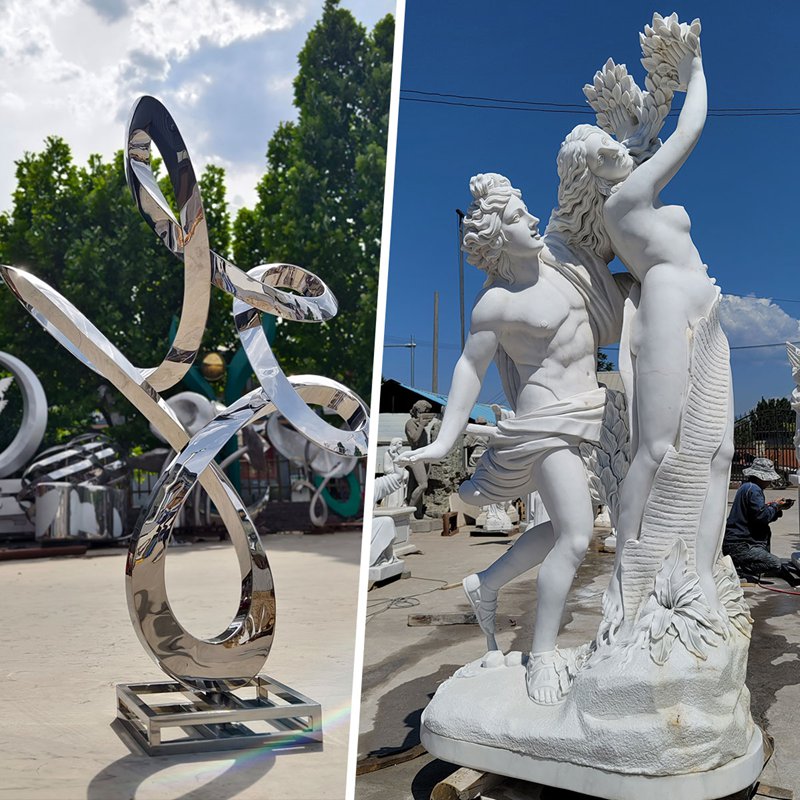
What is a Sculpture?
Sculpture is a broad, three-dimensional art form with virtually no creative limitations. It can depict real-world objects such as people, animals, or natural landscapes, but can also express ideas and emotions through abstract shapes, conceptual installations, or interactive art. The appeal of sculpture lies in the limitless creative freedom it affords the artist—from the choice of material to the design of form, every decision can embody a unique artistic expression.
Traditional sculpture primarily utilizes durable materials such as stone, wood, metal, or clay, while modern artists are experimenting with non-traditional media such as glass, plastic, recycled materials, and even ice and sand. Regardless of the material, sculpture’s core focus is on artistic expression in three dimensions, creating a visual and sensory impact through the interplay of volume, texture, form, and light and shadow.
Sculpture also encompasses a wide range of sizes, from miniature sculptures and figurine-like works to grand public art installations. Classic examples include Rodin’s The Thinker, modern public art such as Anish Kapoor’s Cloud Gate, all of which exemplify the diversity and creativity of sculpture.
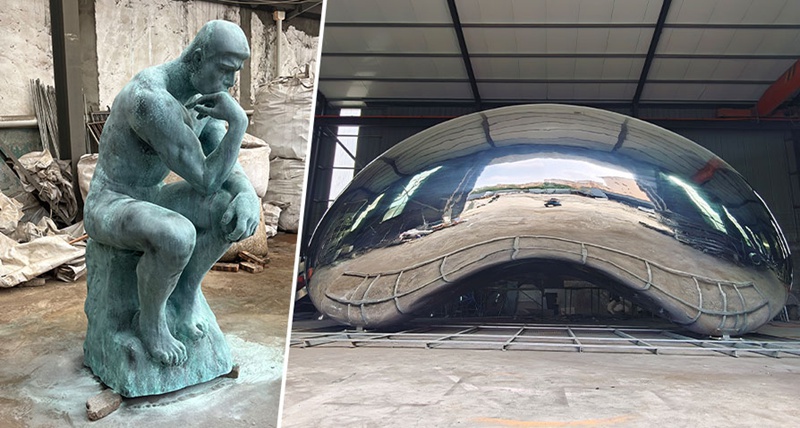
What is a Statue?
A statue is a specific category of sculpture, but it has a more specific purpose and form. Typically, statues focus on the representation of people, animals, or deities, striving for lifelikeness. Compared to abstract or conceptual sculpture, statues emphasize realism and recognizability, and their purpose is often to commemorate, symbolize, or pay tribute.
Statues are typically made from durable, traditional materials such as marble, bronze, stone, and clay to ensure long-term preservation, especially when displayed outdoors in public spaces. Statue sizes range from life-size to larger, while smaller statues are called statuettes. Techniques used include carving, casting (such as the lost wax method), and modeling, each requiring the artist to possess exceptional skill and a keen eye for detail.
Statues have a wide range of uses: they commemorate historical figures, symbolize ideas or beliefs, and serve as public art installations, adorning plazas, gardens, or government buildings. For example, the Statue of Liberty commemorates a symbol of freedom and liberation, while the Statue of Augustus (Augustus of Prima Porta) depicts the majesty and power of the ancient Roman emperor through realistic poses and intricate carving. Other classic examples include equestrian statues, busts, and funerary statues, each of which carries a specific commemorative or symbolic meaning.
These characteristics demonstrate that, while statues fall within the category of sculpture, they are more targeted, emphasizing representational, commemorative, and public expression.

Key Differences Between Statues and Sculptures
Although the terms “statue” and “sculpture” are often used interchangeably in everyday language, they differ significantly in purpose, form, material, and size. Understanding these differences can help art lovers, collectors, and the general public better appreciate and distinguish between them.
1.Artistic Subject
Statue: Typically depicts a figurative figure, animal, or deity, striving for realism and recognizability. The subject matter often has monumental or symbolic meaning.
Sculpture: This has a broader scope and can be figurative or abstract, intended to express ideas, emotions, or concepts without necessarily serving a commemorative purpose.
2.Materials
Statue: Traditionally, durable materials such as marble, bronze, stone, or clay are used to ensure long-term preservation, making it particularly suitable for outdoor display.
Sculpture: The choice of materials is more flexible, and can include metal, wood, glass, plastic, recycled materials, and even ice or sand, emphasizing creativity and experimentation.
3.Size
Statue: Often life-size or larger, emphasizing visual impact and public display. Smaller statues are called statuettes.
Sculpture: Size is unlimited, ranging from miniature works to large-scale installations taller than buildings, offering flexible expression of the artist’s creativity.
4.Purpose and Function
Statue: Primarily serves as a memorial, symbol, or tribute, such as the Statue of Liberty or the Statue of Augustus.
Sculpture: Focuses more on artistic expression and audience interaction, and can be exhibited in galleries or as public art installations.
Feature | Statue | Sculpture |
Art Theme | Representational humans, animals, or deities | Representational or abstract; can express ideas or concepts |
Materials | Marble, bronze, stone, clay | Stone, wood, metal, glass, plastic, recycled materials, etc. |
Size | Typically life-size or larger | Unlimited; can range from miniature to monumental installations |
Purpose | Commemoration, symbolism, or tribute | Artistic expression, conceptual exploration, audience interaction |
Style | Realistic, recognizable | Representational, abstract, or experimental |
Display Location | Public spaces, squares, gardens | Galleries, museums, public spaces, art installations |
Famous Examples of Statues and Sculptures
To better understand the difference between statue and sculpture, here are some new and famous examples:
Statues
- Equestrian Statue of Marcus Aurelius, Rome (Italy): This equestrian statue of an ancient Roman emperor realistically portrays authority and majesty, and is a model of monumentality.
- Statue of Athena Parthenos, Greece: A statue of an ancient Greek deity, embodying religious significance and classical artistic style.
- Michelangelo’s Pietà Statue (St. Peter’s Basilica, Vatican): A religious statue, depicting the Virgin Mary holding Jesus in a realistic scene, with both monumental and religious significance.
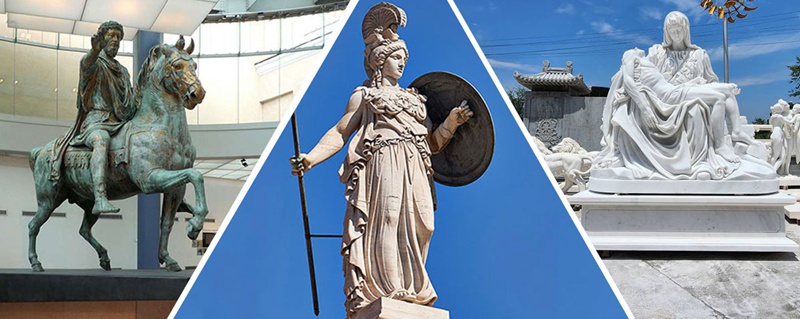
Sculptures
- Lynn Chadwick’s Sitting Couple (UK): A semi-figurative sculpture that depicts the relationship between figures and their interaction with space, combining abstraction with emotional expression.
- Auguste Rodin’s The Walking Man Statue(France): an abstract sculpture emphasizing the dynamics of the human body and the exploration of form, not monumental.
- Yayoi Kusama’s Stainless Steel Pumpkin (Japan/International): This large-scale abstract stainless steel sculpture, combining iconic polka dots with the form of a pumpkin, showcases the visual impact and artistic innovation of modern sculpture.
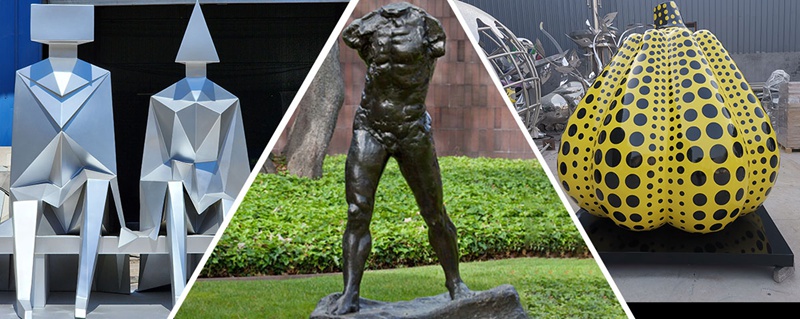
Conclusion
Although the terms statue and sculpture are often used interchangeably, they differ significantly in purpose, form, material, and creative approach. Statues are typically figurative and monumental, commemorating people, animals, or deities; sculpture, on the other hand, is more expansive, capable of abstraction and conceptualization, emphasizing artistic expression and creative exploration. This distinction is clearly evident through classic examples.
At YouFine, we deeply understand the artistic value and nuances of statues and sculptures. Whether you’re looking for a lifelike monumental sculpture or a modern sculpture exploring abstract creativity, we offer professional design, custom sizing, materials, and craftsmanship, ensuring each piece meets your aesthetic needs while also meeting the requirements of your space and intended use. Our experienced team excels at combining creativity with exquisite craftsmanship, making each sculpture or statue a unique artistic signature.
From private gardens to public spaces and exhibition venues, YouFine can help you realize your ideal three-dimensional artwork, transforming statues and sculptures into more than just decorative pieces; they become the artistic soul of the space.



